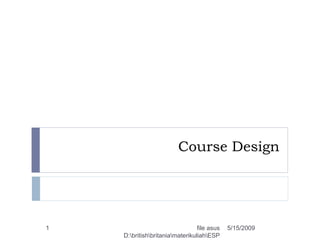
Approaches to course design
- 1. Course Design 1 file asus 5/15/2009 D:britishbritaniamaterikuliahESP
- 2. What is course design ? It is a substantial and important part of the workload Designing a course is fundamentally a matter of asking questions inorder to provide a reasoned basis for the subsequent processes of syllabus design, materials writing, classroom teaching and evaluation. 2 file asus 5/15/2009 D:britishbritaniamaterikuliahESP
- 3. 3 file asus 5/15/2009 D:britishbritaniamaterikuliahESP
- 4. Getting to know the learners In order to develop a course which meets the learner’s communication needs in your language, it will be necessary for you to find out more about the people in your class. 4 file asus 5/15/2009 D:britishbritaniamaterikuliahESP
- 5. Language needs Why are you learning this language ? Will you need to write/read/speak/listen in the language ? In what situation will you use the language ? 5 file asus 5/15/2009 D:britishbritaniamaterikuliahESP
- 6. Approaches to course design Given on the 9th meeting 6 file asus 5/15/2009 D:britishbritaniamaterikuliahESP
- 7. Course design Definition The proces by which the raw data about a lerning is interpreted in order to produce an integrated series of teching-learning experiences, whose ultimate aims is to lead the learners to a particular state of knowledge 7 file asus 5/15/2009 D:britishbritaniamaterikuliahESP
- 8. Language centred course design The aims of the language cetred design are to draw as direct connection as possible between the analysis of the target situation and one content of the ESP course. 8 file asus 5/15/2009 D:britishbritaniamaterikuliahESP
- 9. The figure of a language-centred Identify learners’ target situation Select theoretical views of language Identify linguistic features of target situation Create syllabus Design materials to exemplify Establish evaluation procedures to test acquisition of syllabus terms 9 file asus 5/15/2009 D:britishbritaniamaterikuliahESP
- 10. Skill centred course design The skills-centred approach is founded on two fundamental principles a. Theoritical b. pragmatic 10 file asus 5/15/2009 D:britishbritaniamaterikuliahESP
- 11. Theoretical The basic theoretical hypothesis is that underlying any language behaviour are certain skills and strategies, which the learner uses in order to produce or comprehend discourse. A skills centred approach aims is o get a way from the surface performance data and look at the competence that underlies the performance. 11 file asus 5/15/2009 D:britishbritaniamaterikuliahESP
- 12. Pragmatic The process oriented approach tries to avoid this problem by removing the distinction between the ESP course and the target situation. The ESP course is not seen as a situation performers, because a number of students are likely to achieve this proficiency. 12 file asus 5/15/2009 D:britishbritaniamaterikuliahESP
- 13. A learning centred approach A learning centred approach is based on the principle that learning is totally determined by the learner As teachers we can influence what we teach, but what learners learn is determined by the learners alone. Learning is seen as a process which the learnes use what knowldege or skills they have in order to make sense of the flow of new information. 13 file asus 5/15/2009 D:britishbritaniamaterikuliahESP
- 14. Figure A language centred approach A skills centred approach Identify target situation Analyse target situation Anlayse learning situation Write syllabus Write materials Teach material Evaluate learners achievement 14 file asus 5/15/2009 D:britishbritaniamaterikuliahESP
